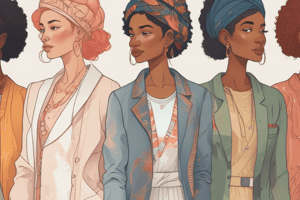Podcast
Questions and Answers
What is the main difference between direct and indirect discrimination?
What is the main difference between direct and indirect discrimination?
- Direct discrimination is based on actions, while indirect is based on policies (correct)
- Direct discrimination is intentional while indirect is unintentional
- Direct discrimination is illegal, while indirect is legal
- Direct discrimination affects individuals, while indirect affects groups
What is victimisation in the context of discrimination?
What is victimisation in the context of discrimination?
- Filing a lawsuit against someone who has discriminated
- Giving false information to support a discrimination claim
- Treating someone unfairly because of their race
- Subjecting a person to a detriment for doing a protected act (correct)
What is the primary basis for racial discrimination?
What is the primary basis for racial discrimination?
- National identity
- Religious beliefs
- Colour of skin (correct)
- Ethnic origins
What is the purpose of the Equality Act 2010?
What is the purpose of the Equality Act 2010?
What is the main consequence of indirect discrimination?
What is the main consequence of indirect discrimination?
What is an example of a protected act under the Equality Act 2010?
What is an example of a protected act under the Equality Act 2010?
What is the main reason why intersex individuals are not covered by the gender reassignment discrimination part of the Equality Act?
What is the main reason why intersex individuals are not covered by the gender reassignment discrimination part of the Equality Act?
What is required for a philosophical belief to be protected under the Equality Act?
What is required for a philosophical belief to be protected under the Equality Act?
What is the term for discrimination based on someone's perceived sexual orientation?
What is the term for discrimination based on someone's perceived sexual orientation?
What is the term for discrimination based on someone's connection to someone with a particular sexual orientation?
What is the term for discrimination based on someone's connection to someone with a particular sexual orientation?
How many main types of disability discrimination are there under the Equality Act?
How many main types of disability discrimination are there under the Equality Act?
What is required for a condition to be considered a disability under the Equality Act?
What is required for a condition to be considered a disability under the Equality Act?
Flashcards are hidden until you start studying
Study Notes
Types of Discrimination
- There are four main types of discrimination: Direct Discrimination, Indirect Discrimination, Harassment, and Victimisation.
Direct Discrimination
- Refers to less favourable treatment against an individual because of their protected characteristic.
Indirect Discrimination
- Occurs when a provision, criterion, or practice is applied in a way that creates disproportionate disadvantage for a person with a protected characteristic.
Victimisation
- Subjecting a person to a detriment because they have done a protected act or there is a belief that they have done a protected act under the Equality Act 2010.
Protected Characteristics
Race
- Includes colour of skin, national identity, or ethnic/national origins.
- Can be the construction of different racial groups (e.g. black Britons, Romany gypsies).
Sexual Orientation
- Protected from discrimination based on being heterosexual, gay, lesbian, or bisexual.
- Also includes discrimination by perception (someone thinks you have a particular sexual orientation) and discrimination by association (connected to someone who has a particular sexual orientation).
Gender Identity
- Trans and non-binary identities are protected from gender reassignment discrimination.
- Changing physiological or other gender attributes is a personal process, not a medical one.
Sex Discrimination
- Relates to male or female, men or women.
- Still a prevalent issue, highlighted by the Athena Swan movement.
Faith/Belief
- Religion or belief can include organised religions, smaller religions, humanists, and those without a belief system.
- A philosophical belief must be genuinely held and more than an opinion.
Disability
- A disability is a physical or mental condition that has a substantial and long-term impact on daily activities.
- Also covers those who had a disability in the past.
Disability Discrimination
- There are six main types of disability discrimination: direct discrimination, indirect discrimination, failure to make reasonable adjustments, discrimination arising from disability, harassment, and victimisation.
Studying That Suits You
Use AI to generate personalized quizzes and flashcards to suit your learning preferences.




